The Medical Nutrition Market is estimated to be valued at USD 17.2 billion in 2025 and is projected to reach USD 31.1 billion by 2035, registering a compound annual growth rate (CAGR) of 6.1% over the forecast period.
The Medical Nutrition market is experiencing substantial growth driven by the increasing emphasis on preventive healthcare and the rising prevalence of chronic and lifestyle-related diseases. The future outlook for this market is shaped by the growing awareness of personalized nutrition and therapeutic dietary interventions, particularly among patients requiring targeted nutritional support.
Continuous advancements in formulation technologies and nutrient delivery systems are enabling the development of specialized products that address specific health conditions effectively. Additionally, increasing investments in healthcare infrastructure and nutrition research are supporting the adoption of medical nutrition solutions across hospitals, clinics, and home care settings.
The market is further propelled by the aging global population, which is more susceptible to malnutrition and nutrient deficiencies, as well as rising patient awareness regarding the role of nutrition in disease management and recovery As healthcare providers focus on integrating nutrition into patient care protocols, the demand for medically tailored nutritional products is anticipated to expand steadily, offering long-term growth potential across both developed and emerging regions.
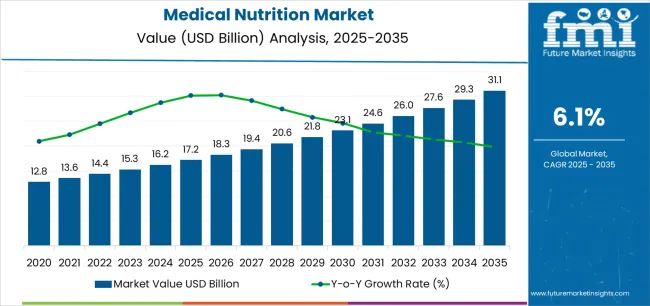
| Metric | Value |
|---|---|
| Medical Nutrition Market Estimated Value in (2025 E) | USD 17.2 billion |
| Medical Nutrition Market Forecast Value in (2035 F) | USD 31.1 billion |
| Forecast CAGR (2025 to 2035) | 6.1% |
The market is segmented by Nutrition Type, Health Condition, Patient Type, Mode of Delivery, and Sales Channel and region. By Nutrition Type, the market is divided into Multivitamins & Antioxidant, Proteins, Carbohydrates, Amino Acids, Fiber, Mineral, and Others. In terms of Health Condition, the market is classified into Cancer, Diabetes, Gastrointestinal Disease, Metabolic Syndrome, and Others. Based on Patient Type, the market is segmented into Adult, Infant, and Geriatric. By Mode of Delivery, the market is divided into Oral, Enteral, and Parenteral. By Sales Channel, the market is segmented into Store-Based Retailing and Online Retailing. Regionally, the market is classified into North America, Latin America, Western Europe, Eastern Europe, Balkan & Baltic Countries, Russia & Belarus, Central Asia, East Asia, South Asia & Pacific, and the Middle East & Africa.
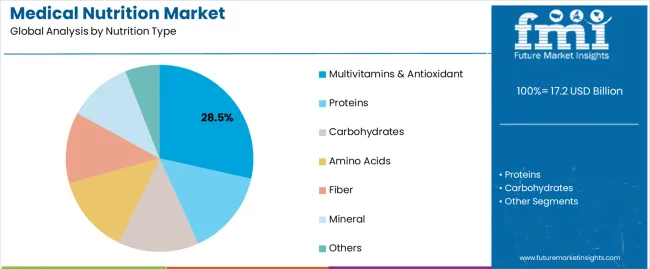
The multivitamins and antioxidant segment is projected to hold 28.5% of the Medical Nutrition market revenue share in 2025, positioning it as a leading nutrition type. This segment has been driven by the broad applicability of multivitamins and antioxidants in supporting immune function, reducing oxidative stress, and improving overall patient health.
Increasing clinical recognition of their role in preventive and adjunctive care has further strengthened adoption. The availability of versatile formulations suitable for various patient needs, including oral liquids, powders, and capsules, has also enhanced accessibility and convenience.
Moreover, the rising interest in holistic health approaches and evidence-based nutrition has reinforced the preference for multivitamins and antioxidants in therapeutic diets The combination of proven efficacy, patient compliance, and adaptability across healthcare settings continues to sustain the dominance of this segment in the market.
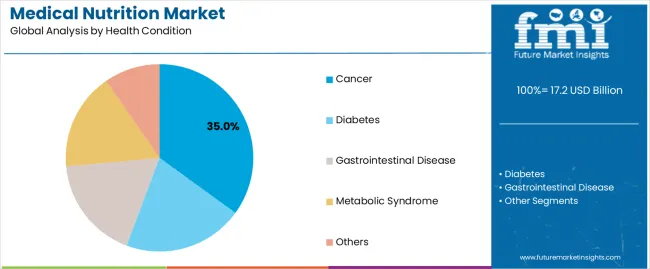
The cancer health condition segment is expected to account for 35.0% of the Medical Nutrition market revenue share in 2025, highlighting its critical role in patient care. Growth in this segment is driven by the increasing integration of nutritional support into oncology treatment protocols to improve patient outcomes, manage side effects, and enhance recovery.
Specialized nutritional formulations are used to address malnutrition, support immune function, and maintain strength during chemotherapy, radiation, and surgical interventions. Awareness among healthcare providers and patients regarding the importance of tailored nutrition in cancer care has significantly contributed to the adoption of medical nutrition solutions.
Additionally, the expanding global incidence of cancer and the rising number of oncology treatment centers are further propelling the demand for nutrition products in this segment The emphasis on improving quality of life and clinical outcomes ensures continued growth of the cancer-focused medical nutrition market.
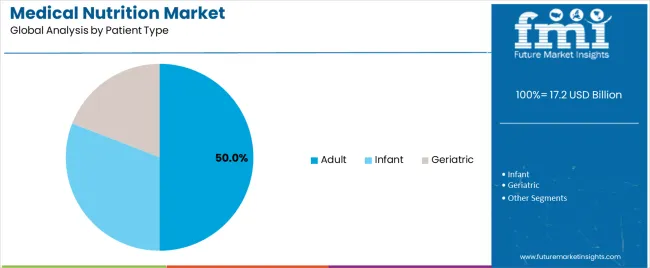
The adult patient type segment is anticipated to account for 50.0% of the Medical Nutrition market revenue in 2025, establishing it as the leading patient category. This growth is influenced by the high prevalence of chronic diseases, age-related nutrient deficiencies, and lifestyle-associated health conditions among adults.
Medical nutrition products designed for adults provide targeted support for energy, immune function, and recovery from illness or surgery. The increasing focus on personalized nutrition, combined with the availability of convenient, ready-to-consume formulations, has enhanced patient compliance and adoption.
Healthcare providers are increasingly recommending tailored nutrition as a standard component of adult patient care, particularly in hospitals, outpatient clinics, and home care settings Furthermore, rising awareness among adults about preventive healthcare and maintaining long-term wellness continues to reinforce the dominance of this patient segment in the medical nutrition market.
Increasing demand for nutritional support for the infant population
A rising awareness of the significance of Paediatric medical nutrition on long-term health drives up the request for baby food for nutritional support. Some company such as Nestle Health Science have also come up with new products tailored to these needs.
Nestle’s Meritene Baby, for example, constitutes a special selection of medical nutrition that addresses cognitive development and immune system development, among others while ensuring that the young ones are well-nourished. Such nutrients comprise vitamins, minerals, and essential fats which help in promoting healthy growth in infants.
The focus remains on delivering safe, effective, and developmental-supportive infant nutrition even as companies continue innovating and expanding their product ranges
Growing diagnoses of gastrointestinal disorders such as IBD and celiac disease driving the medical nutrition industry
In the medical nutrition market, gastrointestinal disorders are on the rise and this includes celiac disease and inflammatory bowel disease (IBD) as well. The number of diagnoses keeps increasing therefore making it necessary for dietary interventions that address the particular requirements of these people.
For example, products such as Nutricia by Danone which is formulated for patients with conditions like IBD. To help patients manage their symptoms and improve their quality of life through scientifically backed formulations and advancing research into diet’s role in disease management, these products are developed to provide directed nutritional support.
It is a confirmation that the market is focusing on developing efficient nutritional treatments for patients with gut illnesses other than just traditional dietary changes alone.
Growing adoption of medical nutrition in developing countries such as India.
In India, the growing use of medicinal diets is influenced by several factors that contribute to enhanced medical services access, surging prevalence of chronic diseases, and rising consciousness about nutrition as it pertains to health care. Diseases like diabetes, cardiovascular conditions, and obesity are increasing. This change in population structure has increased the demand for nutrition interventions that aid in the prevention and management of diseases thus resulting in greater acceptance of medical nutritional products.
One such initiative is the National Nutrition Mission (NNM) or Poshan Abhiyaan aimed at promoting healthcare infrastructure and public health awareness by the Indian Government. For instance, Poshan Abhiyaan is designed to comprehensively miti gate malnutrition across India by targeting maternal and child nourishment.
To improve nutritional outcomes through targeted interventions, public awareness campaigns, and capacity building at the grassroots level, the mission integrates various existing programs and initiatives under one umbrella.
Global Medical Nutrition increased at a CAGR of 5.1% from 2020 to 2025. For the next ten years (2025 to 2035), projections are that expenditure on medical nutrition will rise at 6.4% CAGR
In this period, 2020-2025, the market experienced an increasing demand for specialized nutritional products targeting conditions like malnutrition, diabetes, gastrointestinal disorders, and nutrition requirements associated with oncology. To this end, firms sought to create an expanded line of products that catered to diverse demographic groups and diseases.
Besides that, the growth of personal medicine and digital health where a technology for healthcare was on the rise LED to further market expansion hence improving the effectiveness as well as precision in dealing with nutrition.
From 2025 through 2035 medical nutrition product market is expected to continue to grow at a significant rate. The major drivers include a globally aging population prone to chronic diseases necessitating nutritional support and ongoing medical research advancements that point out the importance of diet in disease prevention and control.
Emerging markets such as those in Asia-Pacific and Latin America are anticipated to witness higher adoption of medical nutrition due to improvements in healthcare infrastructure and rising disposable incomes.
The global medical nutrition industry is dominated by many big players, namely Zeon Lifesciences Ltd., DSM, Abbott, Danone S.A, Baxter, Nestle, GSk plc, Sun Pharmaceutical Industries Ltd, and many more. These business leaders constitute a significant value share.
These brands have extensive good manufacturing practices and distinguish themselves from the competitors by an elaborate distribution network and regional presence. Their products are widely present at retail stores present worldwide. They offer a wide product portfolio accompanied by modern packaging formats. They concentrate on meeting the regulatory standards to garner more consumer trust and build brand loyalty.
Regional brands have a distinct advantage in their ability to cater to local consumers' specific needs and preferences. While they may lack the resources for extensive research and development compared to national brands, regional players make up for it with their deep understanding of the local market and strong connections with their target consumers.
Regional brands adapt quickly to changing market conditions and consumer trends due to their agility and proximity to the local market.
The table below highlights revenue from product sales in key countries. The United States and Germany are predicted to remain top consumers, with estimated valuations of USD 6,506.2 Million and USD 4,912.8 Million, respectively, by 2035.
| Countries | Value (2035) |
|---|---|
| United States | USD 6,506.2 Million |
| Germany | USD 4,912.8 Million |
| Japan | USD 2,018.2 Million |
| China | USD 4,381.7 Million |
| India | USD 3,638.2 Million |
The following table shows the estimated growth rates of the top three industries. China and India are set to exhibit high Medical Nutrition consumption, recording CAGRs of 6.5% and 9.2%, respectively, through 2035.
| Countries | CAGR 2025 to 2035 |
|---|---|
| United States | 4.3% |
| Germany | 5.1% |
| Japan | 7.6% |
| China | 6.5% |
| India | 9.2% |
The sale of medical nutrition in the United States is projected to exhibit a CAGR of 4.3% during the assessment period by 2035, and revenue from the sales of Medical Nutrition in the country is expected to reach USD 6,506.2 million
Significant investments and advances in nutritional sciences make the United States a leader in healthcare R&D. This leadership ensures continuous innovation and development of up-to-date medical nutrition products capable of being tailored to special health conditions and patient demographics.
As exemplified by Abbott Nutrition and Nestle Health Science among others, they have research institutions and academic collaborations within the territory that allow them to introduce new formulations and provide evidence-based nutrition solutions.
Product safety, efficacy, and quality control are extremely strict under the US regulatory framework. The FDA is responsible for approving and regulating medical nutrition products thereby giving assurance to both medical practitioners and consumers. These factors in addition to high consumer demand for health & wellness products have contributed collectively to sustain America’s worldwide dominance on the global sales market of medical nutrition.
Medical Nutrition demand in Germany is expected to rise at a value CAGR of 5.1% during the forecast period 2025 to 2035. By 2035, Germany is expected value share to account for 21.5% of medical nutrition sales in Europe.
In Germany, the availability and effectiveness of medical nutrition products have been changed by technological advances in healthcare and the incorporation of digital health solutions.
Popular remote consultation choices such as Fernarzt and Zava are helping professionals make custom nutritional counseling and dietary recommendations from where they reside. These services depend on secure communication channels and digital tools that guarantee patient privacy while improving access to healthcare.
Similarly, individuals are making use of digital health apps such as MyFitnessPal as well as food-tracking applications that are recommended by their physicians for better monitoring of their diets.
These apps provide instant feedback on dietary patterns thereby allowing users to make informed decisions regarding their nutrition health objectives. In addition, these advancements aim at enhancing patients' involvement while enabling them to comply with prescribed diet plans hence leading to increased efficiency in medical nutritional therapy.
The future of medical nutrition in Germany may be determined largely by companies that invest in telehealth systems with healthcare providers and employ digital health technologies.
Consumption of Medical Nutrition in China is expected to increase at a value CAGR of 6.5% over the next ten years. By 2035, the sale size is forecasted to reach USD 4,381.7 Million, with Japan expected to account for a market share of 48.1% in East Asia.
In China, the demand for medical nutrition products is soaring because of several catalysts such as income changes, premium specialized infant formulas that meet particular dietary requirements and well-being concerns are becoming increasingly popular among Chinese consumers.
Mead Johnson Nutrition, now owned by Reckitt Benckiser Group, and others have since introduced products aimed at promoting brain growth in infants in addition to enhancing their immunity and digestion as preferred by Chinese parents today
| Segment | Multivitamins & Antioxidant (Nutrition Type) |
|---|---|
| Value Share (2025) | 28.5% |
Sales of multivitamins and antioxidants are projected to register a CAGR of 6.7% from 2025 to 2035.
The medical nutrition sector needs multivitamins and antioxidants because they play a key role in upholding general health and mitigating diverse diseases. People embrace dietary supplementations as they are convenient in enhancing their daily consumption of vitamins and minerals, particularly when dieting may be insufficient and some medical conditions require more nourishment.
As a leading provider of nutritional ingredients worldwide, DSM offers various types of multivitamin products in combination with antioxidants that are extensively utilized in the field of medical nutrition.
| Segment | Oral (Mode of Delivery) |
|---|---|
| Value Share (2025) | 32.2% |
The rapidly growing popularity of the oral mode of delivery segment is anticipated to advance at 9.5% CAGR during the projection period.
Advancements in formulation technology have improved the taste, texture, and bioavailability of medical nutrition thereby increasing the popularity of oral mode of delivery.
For instance, Ensure is a commonly known brand for adult oral nutritionals offered in different types such as Ensure Original, Ensure Plus, and Ensure Enlive which are tailored to meet individuals’ various health conditions. These products have been manufactured by considering cases like poor nourishment due to sickness, wounds, and old age.
Conversely, PediaSure is a range of children’s oral liquid nutritional made for kids who might be having problems with growth or may be lacking some nutrients in their diet. The product helps in providing vital nutrients necessary for normal growth and development thus assisting parents to ensure that their children get enough dietary requirements.
This technique uses an oral route provides meet the nutritional needs of diverse patient populations and has several other reasons why customers prefer them among key players in the medical nutrition market.
| Segment | Store Base (Sales Channel) |
|---|---|
| Value Share (2025) | 36% |
Sales of medical nutrition store base sales channel are projected to register a CAGR of 7.3% from 2025 to 2035.
Among various sales channels, store-based retailing, in particular through pharmacies and drug stores has been a popular one for medical nutrition due to the health experts’ guidance offered by these outlets.
Pharmacists and other healthcare professionals must guide patients on medical nutritional product use and selection. They are highly qualified which means customers get tailored advice depending on their physical well-being such as managing diabetes or recovering from surgery
Several consumers trust these firms when it comes to purchasing medical nutrition owing to their past credible reputation for quality and product reliability. The available brands within these retail stores are normally those known to meet standards set by regulating bodies thus making sure that the products they offer are both safe and efficient
One example is CVS Pharmacy in the United States also provides a pharmacy advisor - if the person needs calcium supplement for bone support, then a CVS Pharmacy pharmacist would tell him/her about different forms of supplements available, suggest doses according to the patient’s age and other health conditions, as well as give better times of taking it to enhance absorption.
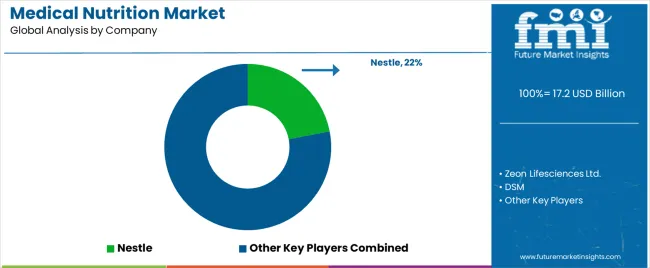
There are numerous key players in the industry. This is a significant point, but no one big player is dominating the market. Market leaders have been focusing on scaling up their production and supply chains to reach out to more consumers. The customers’ want is what is pushing them into such partnerships and alliances (Czinki et al., 2020).
Apart from this, they are also diversifying their product range through different formats and selling via various sales channels.
For example:
In 2025, a partnership between Danone and Bioiberica was established to develop and commercialize nutritional solutions for musculoskeletal health, specifically osteoarthritis. The deal allows Bioiberica to leverage its extensive clinical expertise while Danone could bring its scientific know-how and other competencies to provide proper medical nutrition solutions that meet the needs of patients suffering from movement-related problems associated with aging populations
As per By Nutrition Type, the segment has been categorized into Proteins, Carbohydrates, Multivitamins & Antioxidant, Amino acids, Fiber, Mineral and others.
Health Conditions included Cancer, Diebties, Gastrointestinal disease, metabolic syndrome, and others
This segment is further categorized into infant, adult, and Geriatric
The modes of delivery include Oral, Enteral, and Parenteral
Different Sales channels include Store-based Retailing, (Hypermarkets & Supermarkets, Convenience Store, Drug Stores & Pharmacies, Specialty Stores, and Other Retailers) and Online Retailing
Industry analysis has been carried out in key countries of North America, Latin America, Europe, East Asia, South Asia, Oceania, and the Middle East & Africa.
The global medical nutrition market is estimated to be valued at USD 17.2 billion in 2025.
The market size for the medical nutrition market is projected to reach USD 31.1 billion by 2035.
The medical nutrition market is expected to grow at a 6.1% CAGR between 2025 and 2035.
The key product types in medical nutrition market are multivitamins & antioxidant, proteins, carbohydrates, amino acids, fiber, mineral and others.
In terms of health condition, cancer segment to command 35.0% share in the medical nutrition market in 2025.






Full Research Suite comprises of:
Market outlook & trends analysis
Interviews & case studies
Strategic recommendations
Vendor profiles & capabilities analysis
5-year forecasts
8 regions and 60+ country-level data splits
Market segment data splits
12 months of continuous data updates
DELIVERED AS:
PDF EXCEL ONLINE
Demand for Whey Hydrolysates for Medical Nutrition Drinks in CIS Analysis Size and Share Forecast Outlook 2025 to 2035
Demand of Micellar Casein Isolate (MCI) for Medical Nutrition in EU Size and Share Forecast Outlook 2025 to 2035
Medical Exoskeleton Market Forecast Outlook 2025 to 2035
Medical Display Market Forecast and Outlook 2025 to 2035
Medical Spa Market Size and Share Forecast Outlook 2025 to 2035
Medical Face Shield Market Forecast and Outlook 2025 to 2035
Medical Robot Market Size and Share Forecast Outlook 2025 to 2035
Medical Wax Market Size and Share Forecast Outlook 2025 to 2035
Medical Specialty Bag Market Size and Share Forecast Outlook 2025 to 2035
Medical Plastics Market Size and Share Forecast Outlook 2025 to 2035
Medical Device Tester Market Size and Share Forecast Outlook 2025 to 2035
Medical Device Trays Market Size and Share Forecast Outlook 2025 to 2035
Medical Adhesives Market Size and Share Forecast Outlook 2025 to 2035
Medically Supervised Weight Loss Services Market Size and Share Forecast Outlook 2025 to 2035
Medical Smart Drug Cabinet Market Size and Share Forecast Outlook 2025 to 2035
Medical EMR Input Device Market Size and Share Forecast Outlook 2025 to 2035
Medical Anti-Decubitus Air Mattress Market Size and Share Forecast Outlook 2025 to 2035
Medical Gas Analyzers Market Size and Share Forecast Outlook 2025 to 2035
Medical Biodegradable Magnesium Alloy Market Size and Share Forecast Outlook 2025 to 2035
Medical Holography Market Size and Share Forecast Outlook 2025 to 2035

Thank you!
You will receive an email from our Business Development Manager. Please be sure to check your SPAM/JUNK folder too.
Chat With
MaRIA